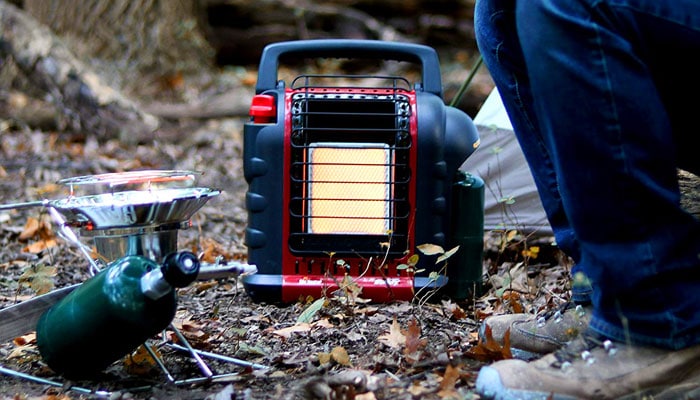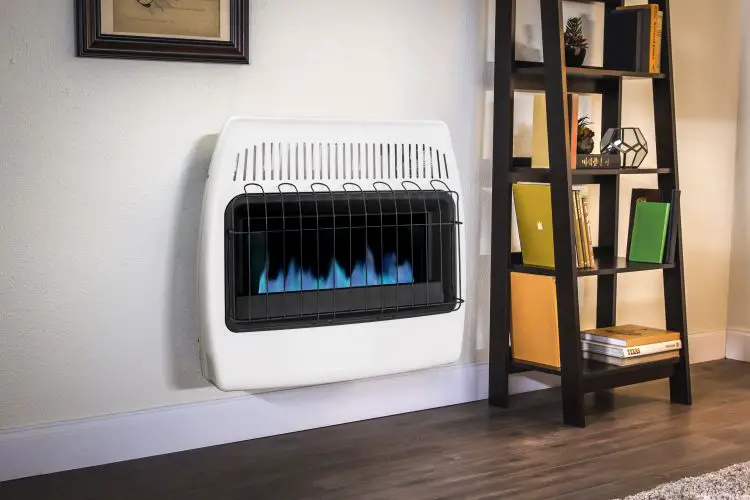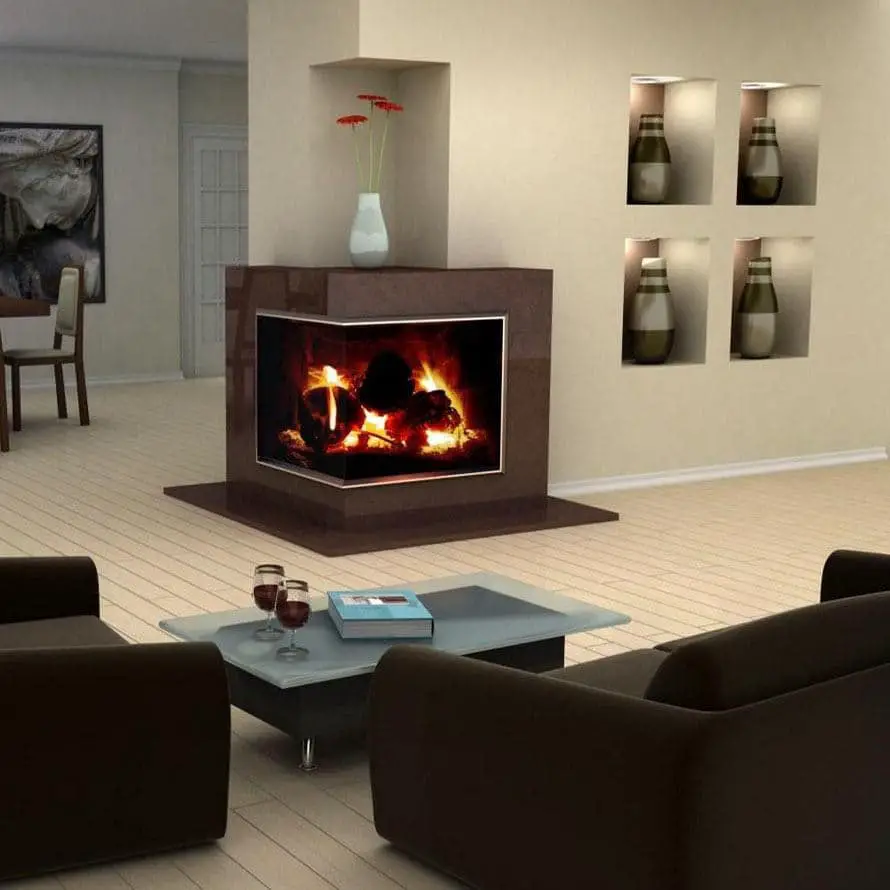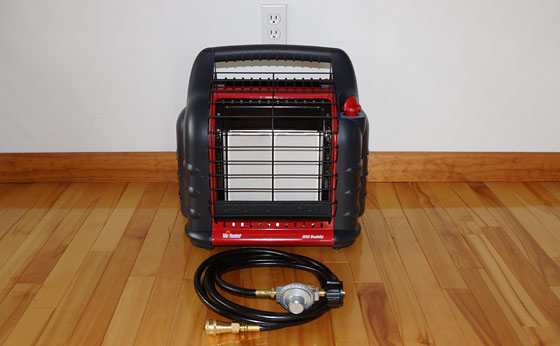With the cold weather approaching, you might be considering options to make some of the colder rooms in your house more comfortable. With rising utility bills and a more severe climate, it may be a good idea to consider indoor propane heaters.
They’re not only cheaper to run than electric heaters, but also, they can easily heat up a room fast. And in some cases are portable enough for camping or outdoor use as well.
In this article, we’ll look at the different styles of an indoor propane heater, how to safely handle them, and suggest some top picks. Let’s get started!
At a Glance: Our Top Picks for Indoor Propane Heaters
- OUR TOP PICK: Mr. Heater F232000 MH9BX Indoor-Safe Portable Radiant Heater
- BEST PORTABLE INDOOR PROPANE HEATER: Mr. Heater F274830 MH18BRV Indoor-Safe Portable RV Propane Heater
- BEST PROPANE HEATER INDOOR WALL MOUNT: Mr. Heater F299730 MHVFB30LPT Vent Free Blue Flame Propane Heater
Comparison of the Best Indoor Propane Heaters
| IMAGE | PRODUCT | |
|---|---|---|
Our Top Pick  |
| VIEW LATEST PRICE → |
 |
| VIEW LATEST PRICE → |
 |
| VIEW LATEST PRICE → |
 |
| VIEW LATEST PRICE → |
 |
| VIEW LATEST PRICE → |
 |
| VIEW LATEST PRICE → |
 |
| VIEW LATEST PRICE → |
Safety Features to Look Out for When Buying an Indoor Propane Heater
Because of the danger of poisonous gases and other emissions, indoor heaters have several additional safety features. They are not typically found on outdoor models.
Because of the need for these safety improvements, it is critical that you never use an outdoor propane heater indoors. Even for a short period of time. All indoor propane heaters will be certified for indoor use.
While the safety features offered by each manufacturer will vary, some of them are common in all of them. All models of indoor heaters include tip protectors that extinguish the flame if the heater is knocked over.

Another safety feature is the oxygen depletion sensor (ODS) that shuts off the heater when the oxygen in the room falls below a safe level.
Overheat protection is a feature that will instantly turn off the burner and gas when the unit overheats. Or if the gas is flowing in while the burner is inactive. Another nifty innovation is one hand piezo ignition, which means you don’t have to bother with lighting up the pilot whenever you want to use the heater. These protections help to make them safer for indoor use.
Review of the Best Indoor Propane Heaters
An indoor propane heater can be a good idea if you want to efficiently and cost-effectively heat up cold spaces in your home. However, with so many models out there, it can difficult to decide. Here’s our round-up of the top picks to help you out.
Best Overall
Mr. Heater F232000 MH9BX Indoor-Safe Portable Radiant Heater

Specifications
Coverage Area (sq ft): 225
BTU/hr Rating: 4000 – 9000
Dimensions: 7.7 x 13.4 x 15 inches
Weight: 9 pounds
We may earn commission from purchases made from our links, at no additional cost to you
Review
This model is a 4000-9000 BTU radiant heater able to heat spaces up to 225 square feet. Amongst its numerous safety features, it shuts off if the pilot light goes out, if it tips over, or if it detects low oxygen. It has a fold-down handle for easy portability.
This is a remarkably effective and powerful heater. A versatile heating solution, it can be used both indoors and outdoors but isn’t suitable for higher altitudes.
Pros
Can be used both inside and outside
Easy to carry around and simple to use
Very fuel-efficient making it quite cheap to run
Plenty of safety features to combat carbon monoxide poisoning and fire risk
Cons
Does not work well at altitudes of 7000 feet above sea level
The exposed flame makes it a little bit of a risk for children and pets
Best Portable Indoor Propane Heater
Mr. Heater F274830 MH18BR

Specifications
Coverage Area (sq ft): 450
BTU/hr Rating: 4000 – 18,000
Dimensions: 19 x 12 x 17.75 inches
Weight: 16.42 pounds
We may earn commission from purchases made from our links, at no additional cost to you
Review
This radiant 4,000-18,000 BTU Liquid Propane heater connects directly to two 1 lb. cylinders and is the perfect solution for heating enclosed spaces like cabins up to 450 sq. ft.
The integrated fan increases the heating capacity of this unit, using both radiant and convection style heat. The built-in Piezo sparking mechanism will take care of the rest. Our safety is ensured by the Oxygen Depletion Sensor (ODS) and accidental tip-over safety shut-off.
This is an extremely effective and powerful heater. It can be used both indoors and outdoors but isn’t suitable for higher altitudes.
Pros
Nearly 100 % efficient
Convenient lighting by pushing and rotating the knob
Low, medium, and high heat level control knob for steady temperatures
Auto shut-off if tipped over, if the pilot light goes out, or if detects low oxygen levels
Cons
The heater may not work at altitudes over 7,000 feet above sea level
Best Propane Heater Indoor Wall Mount
Mr. Heater F299730 MHVFB30LPT

Specifications
Coverage Area (sq ft): 750
BTU/hr Rating: 30000
Dimensions: 23.75 x 11.25 x 27 inches
Weight: 26.8 pounds
We may earn commission from purchases made from our links, at no additional cost to you
Review
Unlike most indoor propane heaters, the Blue Flame heater warms the air using convection, not infrared. It can be put in a narrow area because the heat rises and warms the area from the ceiling down.
It can be turned on automatically using the electronic ignition and can be wall mounted using the included hardware or stand on its own. Producing up to 30,000 BTU of heat, it can warm up to 750 square feet.
This heater uses convection rather than infrared to heat large areas. It is effective indoors but not outdoors, and won’t operate at altitudes over 4,500 feet above sea level.
Pros
Built-in ODS sensor will keep you safe
Produces plenty of heat, enough for 750 square feet
Can be wall-mounted to keep it out of the way of pets and children
Cons
The heater may not work at altitudes over 4,500 feet above sea level
Dyna-Glo RA18LPDG Propane Cabinet Heater

Specifications
Coverage Area (sq ft): 600
BTU/hr Rating: 6000 – 18000
Dimensions: 16.1 x 17.5 x 23.2 inches
Weight: 20 pounds
We may earn commission from purchases made from our links, at no additional cost to you
Review
This portable little heater comes with side carry handles and locking casters for easy portability. It heats up to 600 feet radius, so it works well in large rooms. It can produce 18,000 BTUs of heat and has adjustable heat settings.
For safety, it has a built-in oxygen depletion shutoff (ODS) and is CSA Certified for Safety. It has a piezo igniter for convenient lighting and comes with a 1-year limited warranty.
Both effective and energy-efficient. This little heater has plenty of safety features that will keep you safe during operation. Some users have complained that the tip switch is too sensitive, so keep that in mind.
Pros
Easy to light with piezo lighter
Built-in safety features like ODS
Can be used both indoors and outdoors
Heats up a large area of up to 450 square feet
Cons
Tip switch is quite sensitive, so may create issues for some users
When first used, heater gives off a nasty smell, but this goes away after the first use
Best Indoor Safe Propane Heater
Mr. Heater F215100 MH4B

Specifications
Coverage Area (sq ft): 95
BTU/hr Rating: 3800
Dimensions: 11 x 11 x 11 inches
Weight: 5 pounds
We may earn commission from purchases made from our links, at no additional cost to you
Review
With a low-oxygen sensor, automatic tip-over, overheat shut-off, and a cool-to-touch exterior, this little heater is both safe and effective. It can heat rooms up to 95 square feet and has a simple on/off button.
It is a great little heater for indoor or outdoor heat. It is surprisingly powerful for its small size, but the heat output isn’t adjustable.
Pros
Very good heating for a small heater
Lightweight, making it easily portable
Suitable for use both indoors and outside
The heating surface is coated in porcelain to spread the heat and distribute it evenly
Cons
There is no temperature control; it is either on or off
Difficult to clean, which according to the company, is a common complaint
Best Small Indoor Propane Heater
Dyna-Glo IBF10PMDG

Specifications
Coverage Area (sq ft): 300
BTU/hr Rating: 10000
Dimensions: 17.32 x 9.49 x 20 inches
Weight: 17 pounds
We may earn commission from purchases made from our links, at no additional cost to you
What Recent Buyers Report
The vent-free technology and the advanced heating system are based on the central heating systems being used in homes. The 300 sq ft heating radius has added to the customer’s satisfaction along with the easy relocation of this appliance.
Why it Stands Out to Us
This device provides absolute freedom of movement anywhere you want. The fuel-tank based heating system can help amid emergencies. It is also useful while camping when no other means of heating is available.
Bottom Line
If you need a moveable and high-efficiency heating system, this device is perfect for you. You don’t need a venting system or a gas supply to use this heater. This makes it a very reliable and easy-to-use appliance that can even be used when you are camping or away from home.
Pros
Small size doesn’t demand a lot of space
Offers the most advanced vent-free technology
Has a built-in ODS system that adds to your safety
Very compact and sleek design for a modern household
Comes with an efficiency of 99.99%, which allows maximum use of fuel
Cons
May rattle sometimes at high heat settings
Does not include feet to place it on the ground
Best Vented Indoor Propane Heater
Martin Direct Vent Propane Wall Heater

Specifications
Coverage Area (sq ft): 194
FBTU/hr Rating: 8000
Dimensions: 11.9 x 7.1 x 22.7 inches
Weight: 29 pounds
We may earn commission from purchases made from our links, at no additional cost to you
What Recent Buyers Report
The product has been able to live up to the expectations of customers. They liked that the installation of this heater is very quick and easy. It can be adjusted even without expert supervision. The efficiency is also great and serves as a substitute for electric heaters.
Why it Stands Out to Us
The sleek design of this heater has been aesthetically pleasing and fits well in with modern interiors. While talking about the functionality of this heater, the efficiency does not fall short. It provides nearly 80% efficient heating to your home compared to similar products.
Bottom Line
It offers an easy installation procedure and great efficiency. It also adds to the beauty of your home with no compromise on the system’s heating efficiency. Most customers find this appliance to be well worth the money.
Pros
Durable and according to the safety laws of the USA and Canada
Attach the heater to a gas outlet on your wall for quick installation
Has a built-in thermostat that adjusts heat according to your needs
A large grill with a high flow of warm air embedded in die-cast aluminum
Stylish design that gives you a combination of modern and aesthetic look
Cons
Produces slight noises on pilot mode
Not available in corner fittings and needs to be on a plain wall
Different Styles of Indoor Propane Heaters
Indoor propane heaters come in two types: portable and permanent. Portable heaters can be moved easily to wherever needed and are typically smaller in heating capability. They are normally used to supplement an existing heating system which may inefficiently warm space in the house.
Portable indoor propane heaters are also great for providing heat while camping or during a power failure. Indoor portable heaters generally don’t have extra ventilation.

On the other hand, a permanent indoor heater is usually mounted to a wall in the home and is attached to a larger tank of fuel that is located outside the home. The storage tanks are fixed in place and filled by a delivery truck. These permanent heaters are larger in heating capacity than a portable model.
They are intended to heat a bigger room or an entire house. Most models employ a circulation fan inside the heater to distribute the warm air where needed. Because of their size, these heaters produce a larger volume of exhaust gas that must be vented outside the home for safety.
Comparison Overview
Let’s have a brief comparison between some popular heaters and the fuels used.
Indoor Heater Propane vs Kerosene
While comparing fuel types, we must keep in mind the efficiency and the cost of the fuel being used.
Kerosene is a highly combustible substance that produces a lot of heat. On the other hand, propane burns very effectively and provides a clean source of heat.
Although kerosene is more efficient than propane, the latter is much cheaper and makes up for the difference in efficiency.
Propane can be used in a closed room or tent for heating since it emits no soot or smoke due to its low carbon content. Kerosene has higher carbon content than propane and produces a lot of fine particles. Compounds such as Carbon Mono-Oxide and Sulphur Di-Oxide are also combustion products.

Propane Space Heater Indoor vs Electric
The major difference between propane and electric heaters is the use of propane and electricity. Propane or gas heaters can seldom be used in a completely confined place with no air outlet. Contrary to this, electric heaters can be used in a closed space.
The other significant difference is between the cost price and the running price of these appliances. Electric heaters are cheap to buy while very expensive to run; this comes as no surprise because they rely on electricity. On the other hand, gas heaters have a higher cost price but cheap fuel.
How to Light an Indoor Propane Heater
Not sure how to light an indoor propane heater properly? Here is what you need to do:
- First of all, make sure that the supply line is well-placed and hooked up with your heater, and there are no leakages.
- Next, check the heater’s igniter that is needed to light up the pilot and the incoming gas from the valve.
- Turn on the supply line valve and then turn the knob at the heater’s upper side to pilot mode. Once in the pilot mode, you need to keep pressing the knob for 20 seconds. It may take longer if the heater has not been used in a while.
- Turn the knob counterclockwise to your desired temperature, and the heater will light up.
If you’re confused, be sure to refer to the video below for a full overview of what was just described.
Safety Tips For Handling Indoor Propane Heaters
Ensure ventilation by cracking open a window. It may seem strange to open a window when you’re trying to heat up the place, but you have to avoid filling the room with poisonous gas.
High levels of carbon monoxide can be fatal, and the early signs of poisoning are similar to flu symptoms: a headache, dizziness, and nausea. If you’re feeling these symptoms and suspect the heater isn’t working properly, get some fresh air right away.
Check for gas leaks regularly. And every time you connect your heater to its fuel supply, check the connection points and hoses for damage and/or any potential gas leaks. If you smell gas, try applying soapy water to connections between hoses, the unit, and cylinder, and inspect for bubbling.
Carefully listen for the hiss of gas escaping, and touch the cylinder to feel for extreme cold. If you suspect the connection or cylinder is leaking, do not light the heater—it will need to be replaced.
When running the heater, keep it out of reach of pets and kids and well away from foot traffic. Place it away from flammable materials. And do not store extra LP or propane cylinders near the heater while it’s in use (fuel cylinders should always be stored outside). Also, make sure it’s not too close to your carbon monoxide detector for a more accurate reading.

Conclusion
Propane heaters are both convenient and effective for heating up the colder spaces in your home. Whether it’s a project in your garage or you need to keep warm on a camping trip, a portable propane heater will come in handy for sure.
Keep in mind that indoor propane heaters need to have essential safety features. To prevent gas leaks, carbon monoxide poisoning and overheating. Always ensure that the heater you purchase is rated for indoor use. In case you’ve decided to go for a propane gas heater, consider our top picks above for proven products that will give a great performance.
People Also Ask
If you’re on the hunt for good indoor propane heaters and need some guidance on their safety and installation, then this is the right place for you. Some of the most frequently asked questions are listed here along with their answers, in order to clear your ambiguities.
It depends on the heat settings that you are using for your heater. A gallon of propane gas has a burn rate of around 1,00,000 BTUs. This means that if you run the heater at 30,000 BTUs, it will deplete 1/3 part of gallons per hour.
Most propane heaters are completely reliant on gas as fuel and don’t require any additional electricity to work. So, no electricity is needed in a propane heater.
These heaters don’t require any supply line connection for the propane input. They have built-in tanks at the lower part of the heaters that are filled with propane. They can also store propane for future use or during emergency conditions. Dual-tank top heaters are also currently available in the market.
Ventless heaters don’t require a vent to take in air from outside for combustion since they use the air from their surroundings. Propane produces clean heat and no by-products during its burning, so no vent is needed to expel any gases.
Propane heaters are highly efficient as compared to electric heaters. They can provide up to 99.9% efficient results. Not only this, but they are much cheaper to use than electric heaters.
Propane heaters are used both indoors and outdoors, but they are both different types, and you need to look into the properties of each heater to determine if it is indoor-friendly. Indoor propane heaters have an oxygen depletion sensor and an automatic shut-off feature to ensure user safety.
Yes, you do need ventilation while using a propane heater because it consumes oxygen and emits heat using oxygen. If the oxygen level is low or finished, it starts emitting carbon monoxide, which is poisonous to the lungs and fatal for humans.
When propane gas is fired, it starts breathing oxygen to produce heat. This, in turn, consumes all the available oxygen in the given space, and if the oxygen is fully consumed, and ventilation is not provided, the heaters start giving off carbon monoxide, which is harmful to living things.
Breathing in propane fumes can give you oxygen deprivation and lead to symptoms such as dizziness, nausea, drowsiness, and confusion. They can mess up your brain nerves and even cause brain damage and death. Hence, propane gas, if inhaled, is extremely dangerous and can lead to death in some cases.
Yes, it is safe to run a propane heater in the garage as long as you keep it away from highly inflammable items and provide it enough air and ventilation in the room to not radiate toxic gases such as carbon monoxide. It’s also recommended to install a CO detector as a safety measure.
